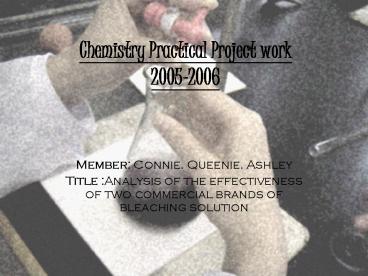Chemistry Practical Project work 20052006 - PowerPoint PPT Presentation
1 / 23
Title:
Chemistry Practical Project work 20052006
Description:
glass dropper x 1. electronic balance x 1. weighing bottle. 250.00 cm3 ... White tile is placed under the conical flask during titration for observation ... – PowerPoint PPT presentation
Number of Views:58
Avg rating:3.0/5.0
Title: Chemistry Practical Project work 20052006
1
Chemistry Practical Project work 2005-2006
- Member Connie. Queenie. Ashley
- Title Analysis of the effectiveness of two
commercial brands of bleaching solution
2
Introduction
- Sodium hypochlorite (Sodium Chlorate(I)) (NaClO)
forms the basis of the most commercial bleaches.
The amount of this active ingredient available
can be estimated by the following method. - In this technique, the Sodium Chlorate (I) is
allowed to react with an excess of Potassium
Iodide (KI) solution in the presence of acid,
liberating Iodine, which is then TITRATED against
Standard Sodium Thiosulphate (Na2S2O3) solution.
3
Theory
- The reaction between iodine and thiosulphate.
- 2 Na2S2O3(aq) I2(aq) ? Na2S4O6(aq) 2NaI(aq)
- The reaction between potassium iodate solution
and potassium iodide solution - KIO3(aq) 5KI(aq) 3H2SO4(aq) ? 3K2SO4(aq) 3
I2(aq) 3 H2O(l)
4
Apparatus equipment
- 250 cm3 beaker x 2
- glass rod x 1
- filter funnel x 1
- wash bottle x 1
- glass dropper x 1
- electronic balance x 1
- weighing bottle
- 250.00 cm3 volumetric flask
- 25.00 cm3 pipette
- pipette pump or Pi-pump x 1
- conical flask
- Burette clamp and stand
- 50.00 cm3 burette x 1
- white tile
- 10.00 cm3 measuring cylinder
5
Chemicals and concentration of solution used
6
Bleaches used
- Clorox and Park N shop Best buy bleach
7
Bleaches used
- Name Clorox (2840 ml)
- Active ingredient sodium hypochlorite 6
8
Bleaches used
- Name Park N shop Best buy bleach (2L)
- Warning more than 1 of active chlorine. Do not
use together with other products. May release
dangerous gases.
9
Experimental Procedure
- Pipette exactly 10 cm3 of the bleach into a clean
volumetric flask (250 cm3 capacity). - Make up to the mark using distilled water.
Shaking well.
10
Experimental Procedure
- Pipette 25 cm3 of this solution into a conical
flask, add 30 cm3 of 0.1M Potassium Iodide
solution and 10 cm3 of 1M Sulphuric acid.
11
Experimental Procedure
- Titrate this against the Standard Sodium
Thiosulphate solution provided and record the
results in a table
12
Experimental Result
- Table to show the result of weighing
- Table to show the result of titration (Clorox)
13
Experimental Result
- Table to show the result of titration (Park
Nshop Best Buy Bleach)
14
Observations
- Solid potassium iodate was white crystalline
solid. Its solution was colourless. - The potassium iodide solution was slightly yellow
although it should be colourless. - Bench 1M sulphuric acid was colorless.
- The potassium iodate solution and potassium
iodide solution produced a pale yellow colour on
mixing.
15
Observations
- When bench 1M sulphuric acid was added to the
mixture of potassium iodate and potassium iodide,
the mixture immediately turned deep brown. - The deep brown mixture turned lighter in colour
when sodium thiosulphate solution was added.
16
Observations
- When the colourless starch solution was added to
the pale yellow reaction mixture, a dark blue
colour was observed.
17
Observations
- At the end point, the dark blue reaction mixture
was discharged (turned colourless/grey).
18
Sources of error
- Starch solution is not fresh because it is
oxidized. - Potassium iodide is not enough to react all ClO-
ions - Parallax occurs when recording the reading of
burette. - The standard potassium iodate solution was not
homogeneous. - The reaction mixture might contained extra amount
of iodine due to oxidation by atmospheric oxygen. - Some iodine molecules might vaporize from the
reaction mixture after its formation.
19
Precautions
- We should wear safety goggles when sulphuric acid
is used. - I2 is added as soon as possible because it
vapours easily. - Starch solution cannot be added too early
otherwise, the black precipitate is formed. - White tile is placed under the conical flask
during titration for observation the colour
change easily - We should label the containers of each solution.
- Any excess potassium iodide solution should be
poured to a special waste bottle and not to the
sink. - We should wash our hands after the experiment.
20
Calculations
- Clorox
- Average of sodium thiosulphate used
- (27.25 27.15 27.40 27.10)/4 27.23cm3
- Mole of sodium thiosulphate
- 0.05071 x 27.23/1000 1.380833 x 10-3 mole
- Mole of iodine produced
- 1.380833 x 10-3 /2 6.90416 x 10-4 mole
- Mole of sodium hypochlorite Mole of iodine
6.90416 x 10-4 mole - Mole of NaOCl in 1 bottle (2840.00 cm3)
- (6.90416 x 10-4) mol x (2840 / 25) cm3 0.07843
mol - Mole of NaOCl per 1
- 0.07843 mol / 21.9 0.003581 mol / 1
21
Calculations
- Park Nshop Best Buy Bleach
- Average of sodium thiosulphate used
- (45.70 44.00 45.10 45.40)/4 45.05 cm3
- Mole of sodium thiosulphate
- 0.05071 x 45.05/1000 2.284485 x 10-3 mole
- Mole of iodine produced
- 2.284485 x 10-3 / 2 1.142242 x 10-3 mole
- Mole of sodium hypochlorite Mole of iodine
1.142242 x 10-3 mole - Mole of NaOCl in bottle (2000 cm3)
- (1.142242 x 10-3) mol x (2000 / 25) cm3
0.091379 mol - Mole of NaOCl per 1
- 0.091379 mol / 10.9 0.008380 mol / 1
22
Conclusion
- After the titration and calculation, the bleach
which has the better effectiveness between two
brands is
23
- Park Nshop Best Buy Bleach































